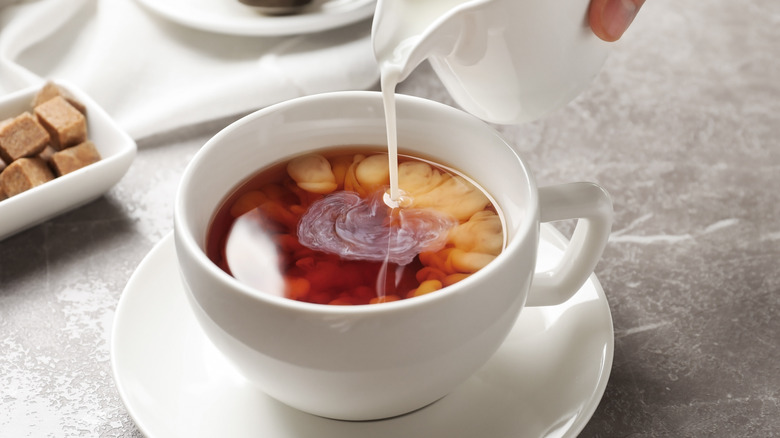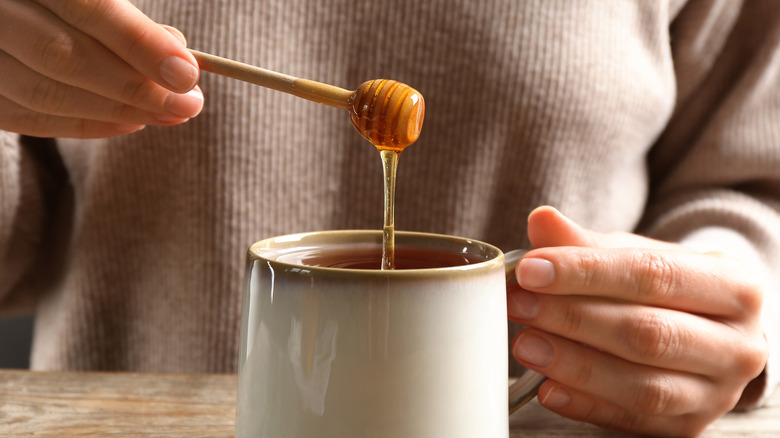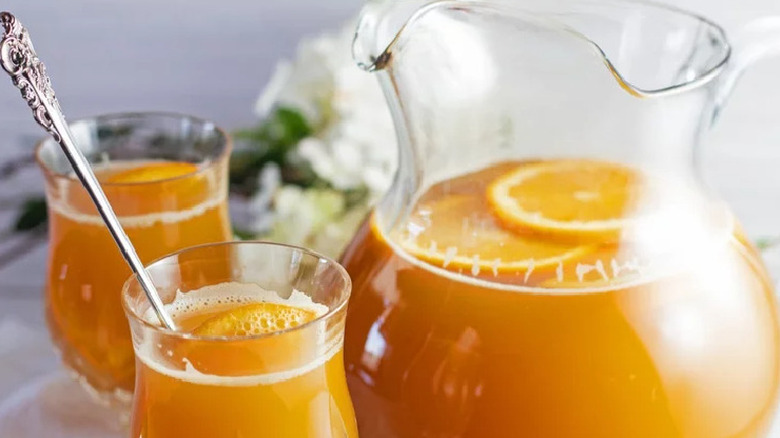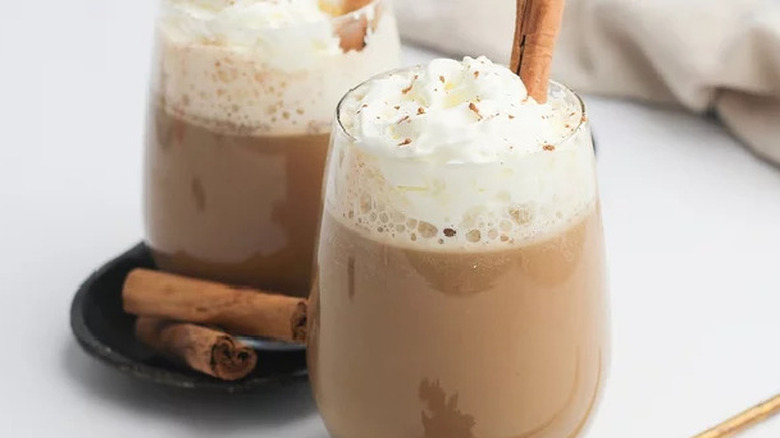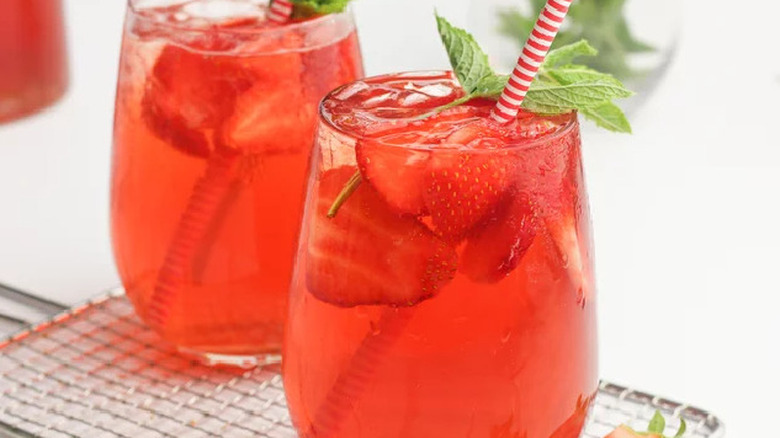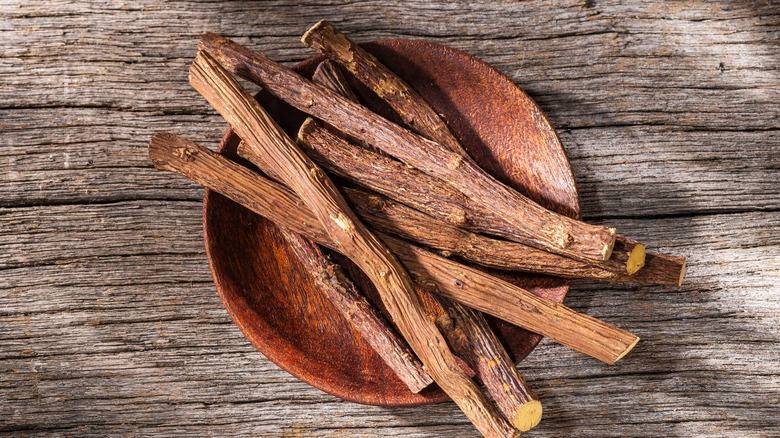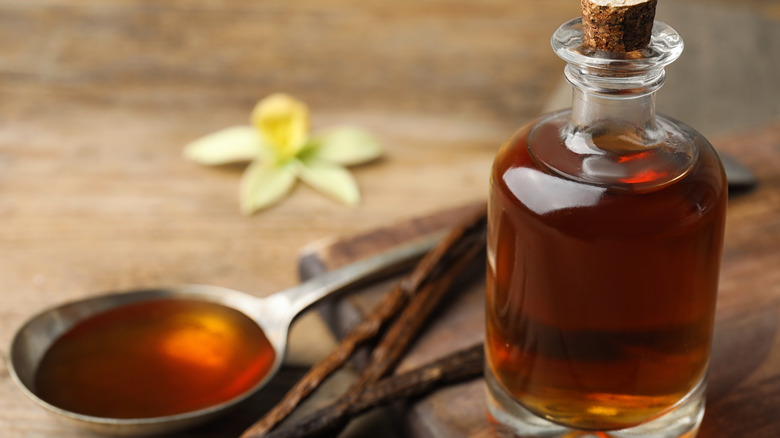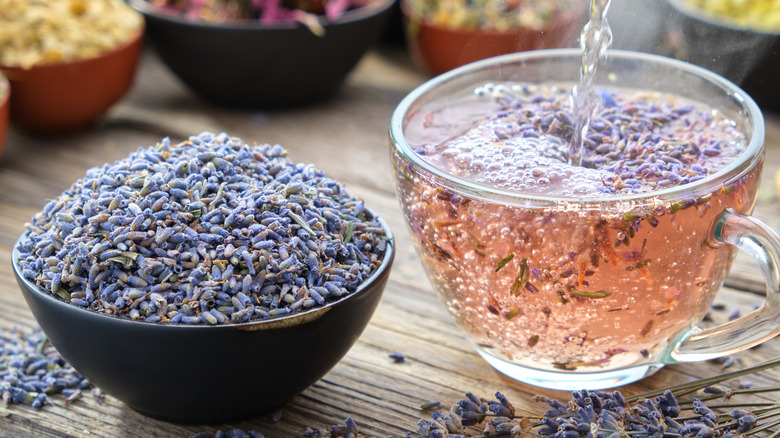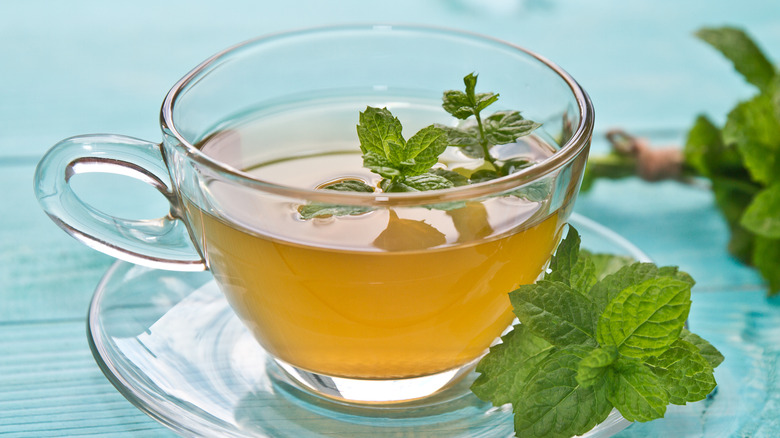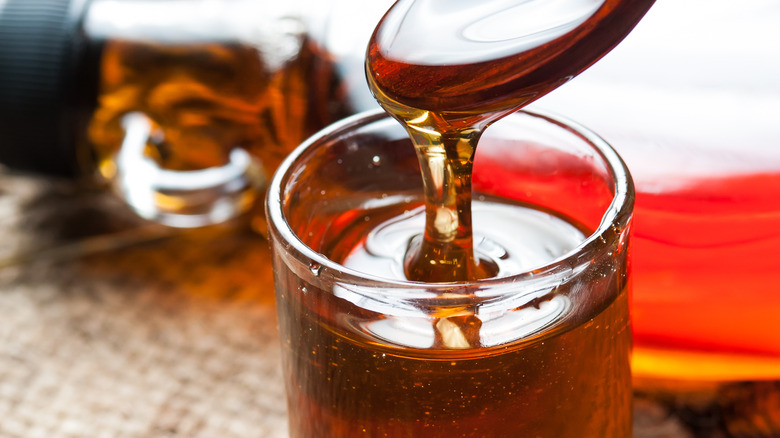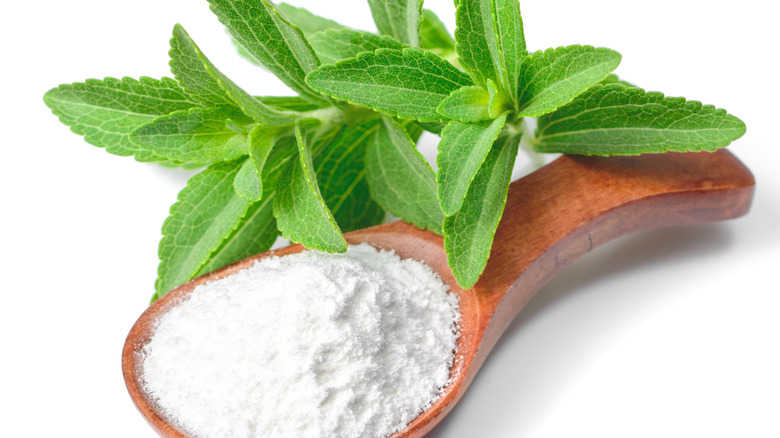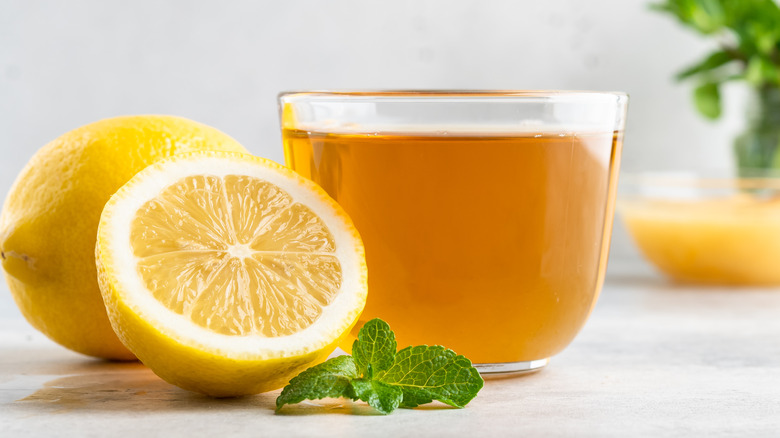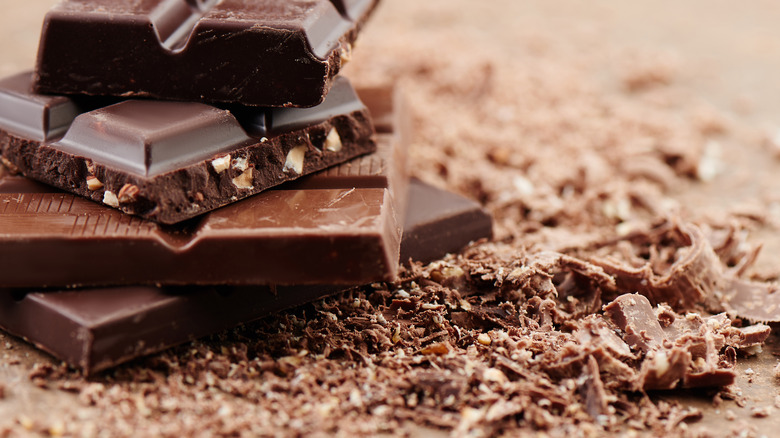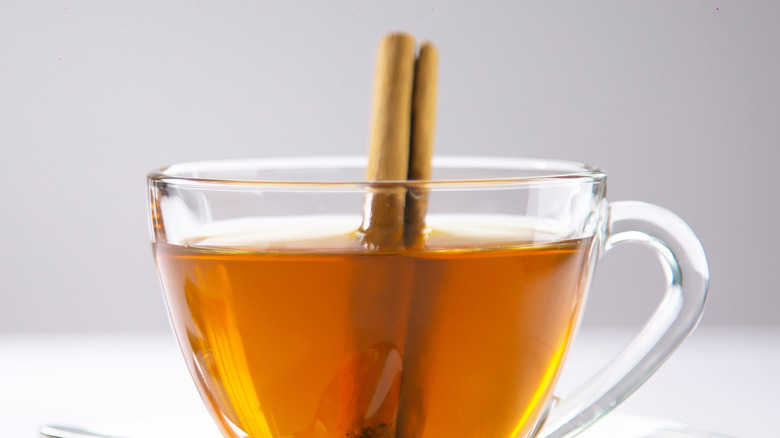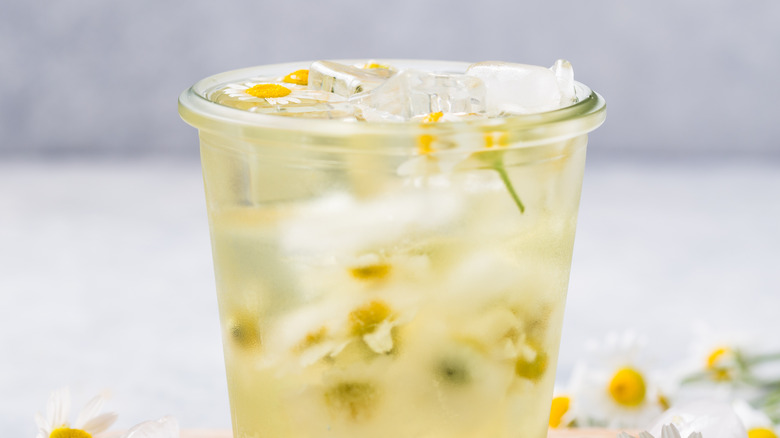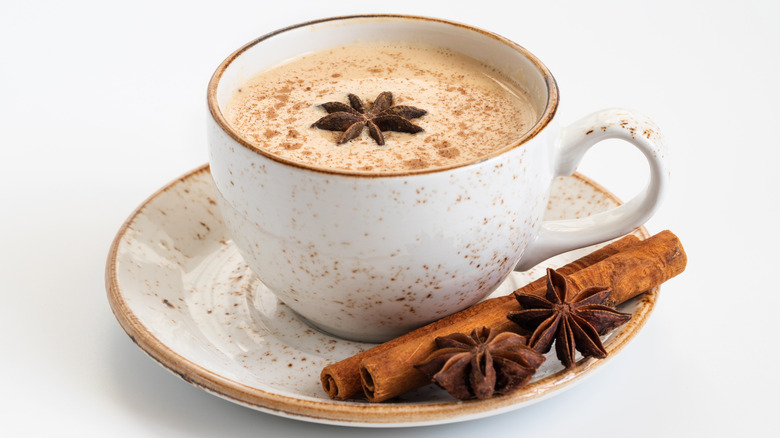15 Things To Add To Your Tea To Make It Taste Better
Tea is a beloved beverage the world over, and for good reason. Not only is tea refreshing, soothing, low in calories, and delicious, but many types of tea also offer a host of health benefits. However, there are some who find tea to be somewhat bland or even unpleasant. If you fall into this camp, never fear! There are a number of easy ways to make tea taste better.
We'll cover sweeteners like honey, stevia, fruit, licorice root, and pure maple syrup. But if sweetened tea doesn't appeal to you, adding peppermint, lemon, dried flowers, or cinnamon may be more your style. How about relaxing at the end of the day with a boozy cup of black tea or a warm, creamy, and spicy chai tea?
With so many different teas — black, white, green, oolong, herbal, and more — and so many possible add-ins, there's no reason not to give this beverage a second chance. It's tastier than you think! Here are 15 of our favorite tea add-ins.
Honey
Honey is a common sweetener for tea, but if you've been using the bear-shaped plastic bottles, you're missing out. With so many honey varieties like wildflower honey, blueberry honey, and heather honey, the kind you use can add depth and sweetness to your tea.
Honey has a few more calories than sugar, but is a healthier option due to its antioxidant properties, according to LiveStrong. Use raw, local honey over processed honey for maximum health benefits. Start with a teaspoon of honey stirred into your hot tea, adding a little more to taste if it's not sweet enough. Honey should never be stirred into boiling hot tea, since it will destroy some of its beneficial properties.
If you're just starting out, you can get inspiration from Sencha Tea Bar's honey and tea pairing suggestions. Earl Grey Tea, for instance, is a black tea flavored with orange rind oil. It pairs beautifully with orange blossom honey, which further enhances the citrus flavor. Green tea with grassy and floral notes pairs well with lavender honey or Tupelo honey. The mild and soothing nature of chamomile tea calls for a mild honey, such as alfalfa honey, which has grassy and vanilla notes.
Fruit juice
Juices are a wonderful way to enhance the taste and sweetness of tea at the same time. We can see this in our traditional Russian tea, for example. The flavor is similar to mulled apple cider and is especially tasty if served hot on cold days or whenever you feel under the weather.
The drink starts off with black tea as its base. Steep about 6 bags of your favorite black tea for about 30 minutes while you bring whole cinnamon sticks and cloves to a boil. You'll then add lemon, pineapple, and orange juice concentrates for that delicious fruity flavor, as well as allspice and sugar to sweeten further. Everything is simmered until ready to serve.
Fruit juice pairs well with other types of tea, too. One Reddit user recommends a morning drink made with orange juice and matcha. We're not sure how tasty those two are together, but another user describes the combination as "robust yet refreshing." To get the layered drink look, pour slowly; otherwise, the two will mix.
Chai latte powder
Skip the cafe, save some money, and make your own chai latte at home. By adding chai latte powder and a couple of other simple ingredients to black tea, you can enhance its flavor. Chai tea lattes are creamy, warmly spiced versions of black tea. A hot version is the perfect way to warm up on a chilly day, but an iced version is a tasty way to cool off in the summer.
Chai latte powder can be found in the tea section of many grocery stores. As for milk, any dairy or plant-based milk will do.
To make this drink for yourself, steep a couple of bags of black tea, and remove the bags after a couple of minutes. Add the chai latte powder, honey, and finally the milk. If you like a frothy latte — and who doesn't? — pour the chai latte into a bowl and whip it with an immersion blender for 30 seconds to make it frothy. Finish it off with a topping of whipped cream and a star anise on top for garnish.
Strawberries
Green tea tastes better when sweetened with ripe, red strawberries. This gives the tea a tangy yet sweet flavor, and gives it a beautiful red color that's great for summer.
To maximize the sweetness and flavor of strawberries, pick them in peak season. Choose strawberries that are a red, vibrant color. White or green spots on strawberries indicate that they were picked before they were ripe, and will taste bitter or sour. You should also remove any berries that have dull, deep red spots — these are overripe.
Our strawberry sweet tea recipe makes enough to serve eight people. You'll bring green tea bags, water, and sugar to a boil for two minutes. Remove the tea bags, add the strawberries, and simmer on medium-low heat for 5 minutes. Pour the tea into a large pitcher after removing the strawberries with a sieve. You can chill it for two hours in the fridge or freeze it for half an hour before serving. When you're ready to drink up, add strawberry slices and mint leaves to the glasses along with the strawberry green tea.
Licorice root
Did you know that licorice root is 50 times sweeter than cane sugar (per WebMD)? No wonder it's so popular in tea! You can add licorice root to herbal tea blends, and it's delicious in ginger tea as well. However, many prefer a tea made out of the licorice root itself. Steep 1 licorice root in 1 cup of boiling hot water for 5 minutes. Strain, then enjoy.
Licorice root has long been used as an herbal remedy for ailments such as sore throats and upset stomach. The licorice coats the throat and stomach, providing relief quickly. And it's not just a folk remedy — licorice root has also shown effectiveness in fighting liver disease, SARS infections, gum disease, and even the development of cavities.
Despite its health benefits, licorice root poses some health risks, too. According to Healthline, the most common side effects are low potassium levels resulting in irregular heartbeat, high blood pressure, and muscle weakness. Although rare, ingesting too much can result in licorice poisoning, which can cause serious damage to the heart, kidneys, and lungs. Pregnant women should avoid licorice, since it can negatively affect brain development in babies. Basically, do not drink licorice root tea if you are pregnant, or if you have heart problems, high blood pressure, or kidney disease.
Vanilla extract
If you've ever had a London Fog, you already know that adding vanilla to tea is a delicious combination. Many cafes use vanilla syrup, but that can be too sweet for those of us who don't want to overpower tea with sweeteners. Vanilla extract provides the perfect balance of vanilla flavor and sweetness, while still allowing the flavor of the tea to shine through.
To make your own London Fog at home, start with Earl Grey tea that's been steeped for 5 minutes. Earl Grey has a delightful citrus flavor thanks to the oil from bergamot orange rind. While that steeps, steam half a cup of milk. The heated milk can be whipped for 5 minutes or foamed with a handheld frother. You can use almond, coconut, or dairy milk. After combining equal parts of tea and milk, add half a teaspoon of pure vanilla extract to enhance the flavor. Sprinkle a bit of sugar, or add some honey if you want it sweeter. And voilà! You've made yourself a delicious hot drink that's perfect for a foggy, rainy morning.
Dried flowers
Dried flowers can improve the flavor of your tea, make it look more beautiful, and boost its health benefits. Popular flowers to combine with tea are roses, lavender, jasmine, and calendula. If you're using your own fresh or dried flowers, make sure they're free from pesticides and are washed thoroughly to remove dirt and debris. When buying from a shop, make sure the flowers are food grade.
Rose petals can be combined with black tea or herbal tea to produce an aromatic and floral taste (via Artful Tea). However, you can make a pure rose tea using rose petals and water, too. Roses are rich in antioxidants known to reduce the effects of type 2 diabetes, certain types of cancer, and heart disease (per Healthline). Roses are good for urinary tract health, memory, and eye health, and also serve as an anti-inflammatory. Rose tea may even reduce menstrual pain!
Lavender — known for its calming effects — pairs well with chamomile tea for a relaxing drink that will help you fall asleep faster. According to Healthline, it's also beneficial for menstrual cramps, skin health, and for boosting mood. Lavender, just like roses, can be made into a tea using the dried flowers alone.
Peppermint
The flavors of peppermint can be described as refreshing, sharp, and icy; it is a tasty addition to green or black tea. Menthol is what gives mint its distinct flavor, and peppermint contains a lot of it — 40% menthol, to be more specific. Peppermint leaves can be brewed alone to create peppermint tea, which can be consumed as-is or combined with other kinds of tea. A drop or two of peppermint extract will do the trick if you don't have peppermint leaves.
Although we have specified peppermint here, many types of mint can be made into tea. Spearmint, apple mint, and grapefruit mint are a few of the more common varieties you can grow and try.
When you combine this ingredient with tea, you'll get more than just a minty flavor. WebMD cites several health benefits associated with peppermint tea, including boosting the immune system to protect the body from infection. Peppermint aids digestion, reduces cramps, and eases irritable bowel syndrome symptoms. Nevertheless, it's not for everyone. Avoid this beverage if you suffer from acid reflux, GERD, or kidney stones. Also, stay away if you take medications for diabetes, blood pressure, or certain medications prescribed to organ transplant patients.
Pure maple syrup
There's more to maple syrup than pancakes! It's a sweet and silky smooth addition to your morning cup of tea, too. While it won't work with any tea, part of the fun is in experimenting to find the right complementary flavor. The tea, for instance, needs to be on the stronger side, since a mild one, such as green tea, will be overpowered by the flavor of the syrup.
Reddit users recommend pairing pure maple syrup with chai tea, or a strong black tea like Irish, Scottish, or English breakfast tea. Hot tea is the best method for using it, since it is easier to dissolve completely.
According to Healthline, there are two grades of maple syrup: A (the lighter syrups) and B (the darker syrups). The lighter maple syrup has a milder flavor and is drizzled on pancakes, fruit, and other foods. Maple syrup with a darker color has a stronger flavor and is best used for baking. Despite being marketed as a healthier alternative to sugar, it still contains a high amount of sugar. Despite this, it does contain some minerals and antioxidants that sugar does not. When using maple syrup in your tea, use it sparingly.
Stevia
Stevia is becoming increasingly popular as a "healthier" sugar substitute. The sweetener is made from a plant extract instead of being created in a lab, like other sugar substitutes. However, the stevia extract sold in stores is not a pure plant extract. It is blended with additives such as erythritol, maltodextrin, and dextrose.
WebMD notes that stevia is 100 to 300 times sweeter than sugar, so a little goes a long way. Keep that in mind when adding it to your tea. Whenever you try it for the first time, add only a couple of drops or half a packet to see if you like it. Some describe the flavor as bitter, menthol-like, or similar to licorice, which may or may not appeal to you.
You should remember that only purified stevia is generally considered safe by the FDA. Using whole leaves or crude extracts is not recommended. More studies are needed, but according to Healthline, raw stevia may be harmful to the heart, kidneys, and reproductive systems. Also, it may affect gut flora and cause bloating and diarrhea. The sweetener is not recommended for pregnant women.
Lemon
Tea and lemon are a classic combination, like peanut butter and jelly. Not only does lemon add a bright flavor to tea, but the combination of citrus and tea also has many health benefits. This is especially true of green tea and lemon, but it's delicious and nutritious in black tea as well.
Healthline reports that green tea with lemon has many health benefits. Both ingredients are rich in antioxidants, helping the body fight against chronic diseases such as cancer, diabetes, obesity, and heart disease. Need to lose weight? Try adding green tea and lemon to your diet. Green tea boosts your body's ability to burn fat, and lemon helps prevent weight gain. It's good for the old noodle, too: Green tea is linked to better brain health, because it lowers the risk of dementia and Alzheimer's. Both green tea and lemon can lower the risk of kidney stones, help prevent infections, and reduce risk factors for heart disease. Plus, this tasty duo is an excellent way to stay hydrated because it's delicious hot or cold.
But you don't have to give up your black tea to get the health perks of the lemon and tea combo. According to SFGate, adding lemon instead of milk, sugar, or whipped cream saves on calories and makes for a more refreshing drink. Since both are diuretics, the combination prevents water retention. Like green tea, black tea can help reduce inflammation, as well as the risk of high blood pressure and heart disease.
Chocolate
It may sound like a strange combination, but adding chocolate to your tea can be quite tasty. For the most health benefits, add dark chocolate. According to the Cleveland Clinic, dark chocolate has fewer calories and fat, but is high in flavonols. It contains two or three times the amount of these healthful compounds as milk chocolate. Flavonols are good for your heart, help lower blood pressure, and fight cell damage. But if you're looking to make your tea sweet and creamy, a semi-sweet chocolate or milk chocolate may be more to your liking.
According to one Quora user, you shouldn't add chocolate directly to your cup of tea. Instead, grate the chocolate into a small plate — about 1 ounce per cup of tea. Once the tea is steeped, add a few ounces of it to a saucepan along with the grated chocolate. Let it simmer until the chocolate is melted and fully incorporated into the tea. Pour that mixture into the remaining tea, giving it a good stir to mix it all together. Sip and enjoy!
Cinnamon
Cinnamon is a delicious addition to tea, and can even be made into a tea itself. It's commonly added to black tea along with other spices to make masala chai, but feel free to add it to your breakfast tea, green tea, or herbal tea. To make cinnamon tea, steep a cinnamon stick in hot water for about 10-15 minutes, or mix 1 teaspoon of ground cinnamon in 1 cup of boiling water. If you want to mix it with another flavor of tea, add your tea bag to the cinnamon tea to steep a few minutes more.
Not only do you get the tasty flavor of the cinnamon, but you'll reap its health benefits, too. According to Diabetes Care, even 1 gram (approximately ⅓ teaspoon) of cinnamon per day reduces the risk factors of type 2 diabetes and heart disease. Healthline also reports many benefits, such as reducing inflammation and lowering blood pressure, blood sugar, and bad cholesterol. Cinnamon helps freshen breath and prevent tooth decay because of its antibacterial properties. Further, it reduces menstrual cramps without pain-relieving drugs. Plus, it's caffeine-free!
Alcohol
Adding bourbon, vodka, or rum can add flavor and a pleasant boozy finish to your cup of tea. One of our favorite suggestions is the Moroccan Etiquette. It's a combination of mint tea, vodka, brown sugar syrup, and yellow chartreuse.
But if you have quite the collection of booze and tea, Reddit has some interesting combinations for you to try. One user recommends green tea, champagne, and simple syrup with a strawberry garnish. Another says that black ginger or ginger peach tea pairs well with whisky, brandy, or rum. In fact, the combination of black tea with honey and bourbon is said to be similar to a hot toddy. Honey liqueur can be used in just about any tea blend. Some of the more interesting flavor combinations recommended were using Baileys Irish Cream in place of milk for chai teas and adding Kahlua to chocolate teas.
With so many possibilities, tea cocktails definitely need to become more mainstream.
Milk
Tea snobs may balk at adding anything to tea, but many of us prefer ours with milk and sugar to sweeten and thicken the drink. But adding milk to tea wasn't always about taste. You'll be surprised to find out that it had a much more practical purpose.
Historically, as far back as the 1700s, milk was used to cool down the liquid. You see, fine china cracked easily in those days when exposed to boiling hot tea, so people started adding cold milk to the cup first to cool it down. These days, you don't need to add the milk first to most teacups. Instead, add it after the tea to ensure that you add the right amount. However, if you're serving tea in fine bone china, you should warm up the cup and let the water stop boiling before pouring it in (per Halcyon Days).
Milk is best with black tea, as you'd find with masala chai. Avoid adding milk to green tea and other varieties.
